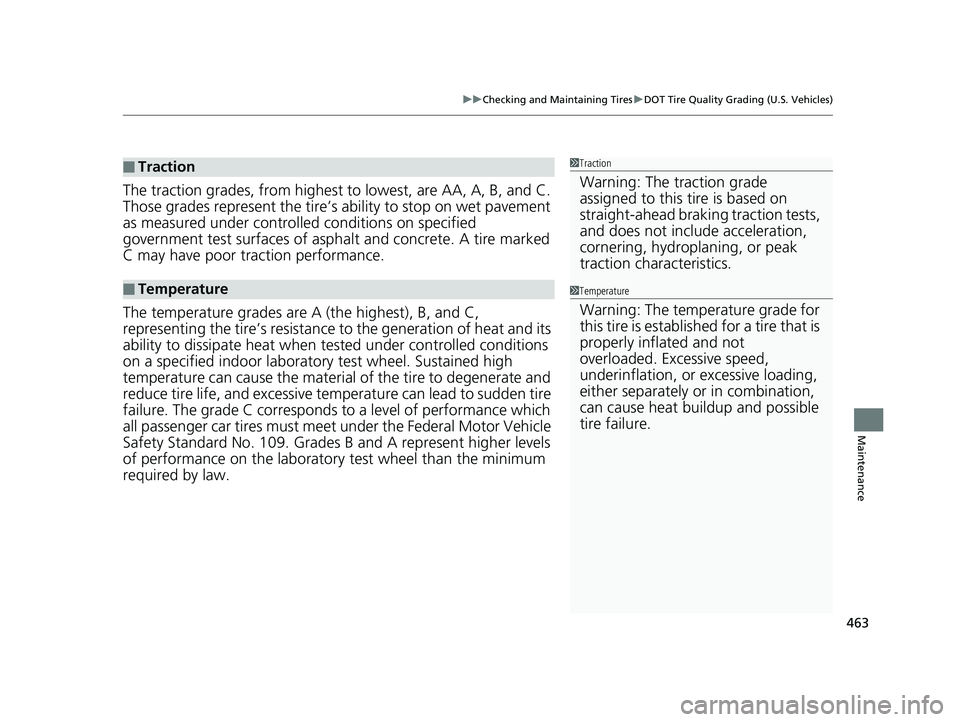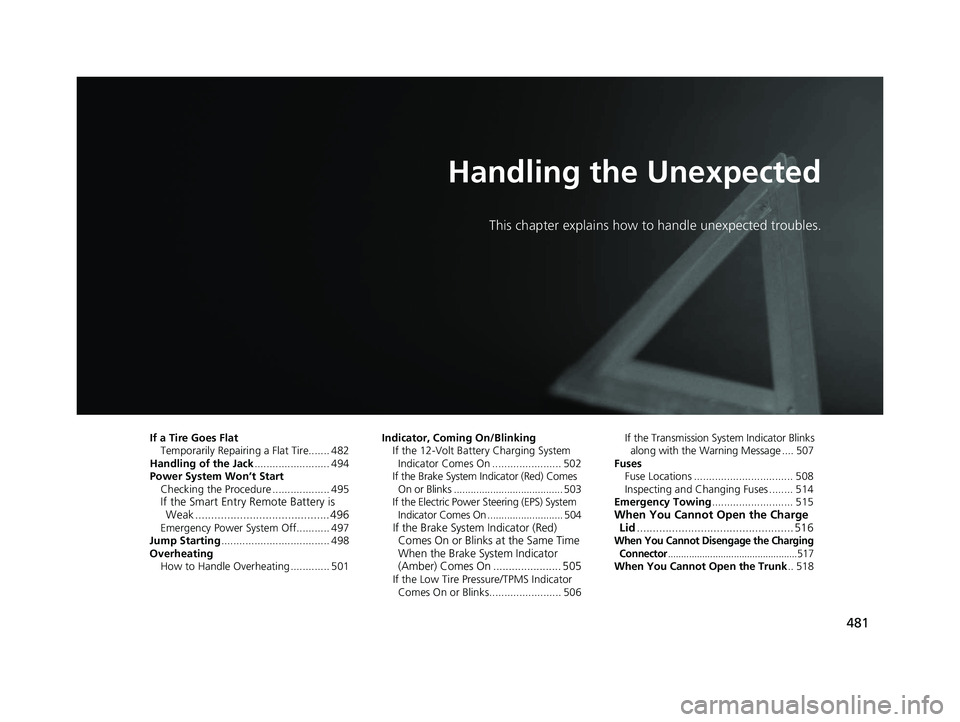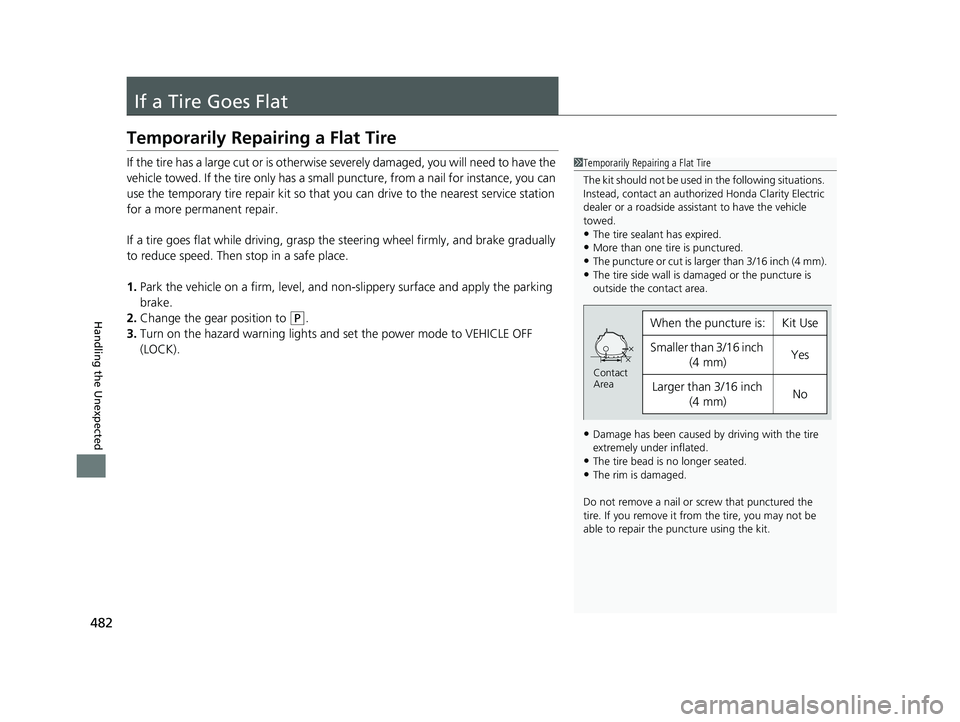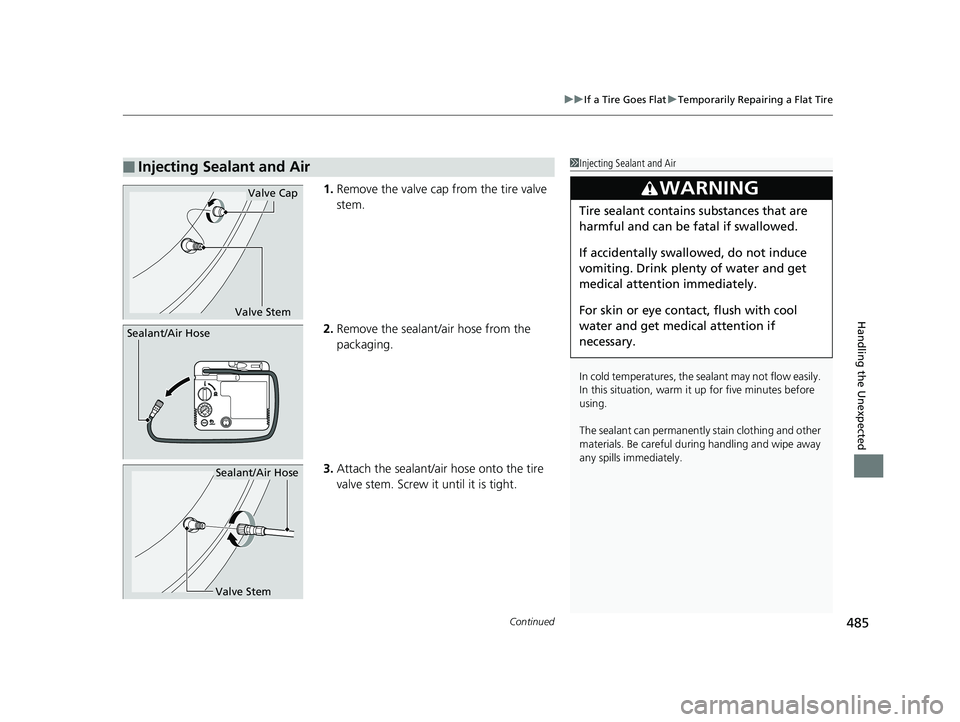Page 465 of 543

463
uuChecking and Maintaining Tires uDOT Tire Quality Grading (U.S. Vehicles)
Maintenance
The traction grades, from highest to lowest, are AA, A, B, and C.
Those grades represent the tire’s ability to stop on wet pavement
as measured under controlled conditions on specified
government test surfaces of asph alt and concrete. A tire marked
C may have poor traction performance.
The temperature grades are A (the highest), B, and C,
representing the tire’s resistance to the generation of heat and its
ability to dissipate heat when te sted under controlled conditions
on a specified indoor laboratory test wheel. Sustained high
temperature can cause the material of the tire to degenerate and
reduce tire life, and ex cessive temperature can lead to sudden tire
failure. The grade C corresponds to a level of performance which
all passenger car tires must meet under the Federal Motor Vehicle
Safety Standard No. 109. Grades B and A represent higher levels
of performance on the laboratory test wheel than the minimum
required by law.
■Traction
■Temperature
1 Traction
Warning: The traction grade
assigned to this tire is based on
straight-ahead braking traction tests,
and does not include acceleration,
cornering, hydroplaning, or peak
traction characteristics.
1Temperature
Warning: The temperature grade for
this tire is establishe d for a tire that is
properly inflated and not
overloaded. Excessive speed,
underinflation, or excessive loading,
either separately or in combination,
can cause heat buildup and possible
tire failure.
17 CLARITY BEV CSS-31TRV6000.book 463 ページ 2017年4月14日 金曜日 午前11 時8分
Page 466 of 543
464
uuChecking and Maintaining Tires uWear Indicators
Maintenance
Wear Indicators
The groove where the wear indicator is
located is 1/16 inch (1.6 mm) shallower than
elsewhere on the tire. If the tread has worn so
that the indicator is ex posed, replace the tire.
Worn out tires have poor traction on wet
roads.
Tire Service Life
The life of your tires is dependent on many factors, including driving habits, road
conditions, vehicle loading, inflation pre ssure, maintenance history, speed, and
environmental conditions (even when the tires are not in use).
In addition to regular in spections and inflation pres sure maintenance, it is
recommended that you have annual inspecti ons performed once the tires reach five
years old. All tires should be removed fro m service after 10 years from the date of
manufacture, regardless of their condition or state of wear.
Example of a Wear
Indicator mark
17 CLARITY BEV CSS-31TRV6000.book 464 ページ 2017年4月14日 金曜日 午前11 時8分
Page 483 of 543

481
Handling the Unexpected
This chapter explains how to handle unexpected troubles.
If a Tire Goes FlatTemporarily Repairi ng a Flat Tire....... 482
Handling of the Jack ......................... 494
Power System Won’t Start Checking the Procedure ................... 495
If the Smart Entry Remote Battery is Weak .......................................... 496
Emergency Power System Off........... 497
Jump Starting .................................... 498
Overheating How to Handle Overheating ............. 501 Indicator, Coming On/Blinking
If the 12-Volt Battery Charging System Indicator Comes On ....................... 502
If the Brake System Indicator (Red) Comes On or Blinks ....................................... 503
If the Electric Power Steering (EPS) System
Indicator Comes On ........................... 504If the Brake System Indicator (Red) Comes On or Blinks at the Same Time
When the Brake System Indicator
(Amber) Comes On ...................... 505
If the Low Tire Pressure/TPMS Indicator
Comes On or Blinks........................ 506 If the Transmission System Indicator Blinks
along with the Warning Message .... 507
Fuses
Fuse Locations ................................. 508
Inspecting and Changing Fuses ........ 514
Emergency Towing ........................... 515
When You Cannot Open the Charge
Lid ................................................. 516
When You Cannot Disengage the Charging
Connector.................................................517When You Cannot Open the Trunk .. 518
17 CLARITY BEV CSS-31TRV6000.book 481 ページ 2017年4月14日 金曜日 午前11 時8分
Page 484 of 543

482
Handling the Unexpected
If a Tire Goes Flat
Temporarily Repairing a Flat Tire
If the tire has a large cut or is otherwise severely damaged, you will need to have the
vehicle towed. If the tire only has a smal l puncture, from a nail for instance, you can
use the temporary tire repair kit so that you can drive to the nearest service station
for a more permanent repair.
If a tire goes flat while driving, grasp the steering wheel firmly, and brake gradually
to reduce speed. Then stop in a safe place.
1. Park the vehicle on a firm, level, and non-slippery surface and apply the parking
brake.
2. Change the gear position to
(P.
3. Turn on the hazard warning lights an d set the power mode to VEHICLE OFF
(LOCK).
1 Temporarily Repairing a Flat Tire
The kit should not be used in the following situations.
Instead, contact an authorized Honda Clarity Electric
dealer or a roadside assi stant to have the vehicle
towed.
•The tire sealant has expired.•More than one tire is punctured.
•The puncture or cut is larger than 3/16 inch (4 mm).
•The tire side wall is da maged or the puncture is
outside the contact area.
•Damage has been caused by driving with the tire
extremely under inflated.
•The tire bead is no longer seated.•The rim is damaged.
Do not remove a nail or screw that punctured the
tire. If you remove it from the tire, you may not be
able to repair the puncture using the kit.
When the puncture is:Kit Use
Smaller than 3/16 inch (4 mm)Yes
Larger than 3/16 inch
(4 mm)No
Contact
Area
17 CLARITY BEV CSS-31TRV6000.book 482 ページ 2017年4月14日 金曜日 午前11 時8分
Page 485 of 543
Continued483
uuIf a Tire Goes Flat uTemporarily Repairing a Flat Tire
Handling the Unexpected
■Getting Ready to Temporarily Repair the Flat Tire1Getting Ready to Temporarily Repair the Flat Tire
Repair notificati on label and speed restriction label
are applied to the side of temporary tire repair kit.
When making a temporary repair, carefully read the
instruction manual provided with the kit.
Pressure Gauge AIR Power Plug
Pressure Relief Button
Repair Notification LabelInstruction Manual
Sealant/Air Hose
REPAIR
Inflator Switch
Speed Restriction Label
Selector Knob
17 CLARITY BEV CSS-31TRV6000.book 483 ページ 2017年4月14日 金曜日 午前11
時8分
Page 486 of 543
484
uuIf a Tire Goes Flat uTemporarily Repairing a Flat Tire
Handling the Unexpected
1. Remove the charging cable by releasing the
belt.
2. Pull the strap on the right side of the trunk
and open the lid.
3. Open the fastener and take the kit out of
the trunk.
4. Place the kit face up, on flat ground near
the flat tire, and away from traffic. Do not
place the kit on its side.
Charging Cable
Lid
Fastener
Strap
17 CLARITY BEV CSS-31TRV6000.book 484 ページ 2017年4月14日 金曜日 午前11 時8分
Page 487 of 543

Continued485
uuIf a Tire Goes Flat uTemporarily Repairing a Flat Tire
Handling the Unexpected
1. Remove the valve cap from the tire valve
stem.
2. Remove the sealant/air hose from the
packaging.
3. Attach the sealant/air hose onto the tire
valve stem. Screw it until it is tight.
■Injecting Sealant and Air1Injecting Sealant and Air
In cold temperatures, the sealant may not flow easily.
In this situation, warm it up for five minutes before
using.
The sealant can permanentl y stain clothing and other
materials. Be careful duri ng handling and wipe away
any spills immediately.
3WARNING
Tire sealant contains substances that are
harmful and can be fatal if swallowed.
If accidentally swallowed, do not induce
vomiting. Drink plenty of water and get
medical attention immediately.
For skin or eye contact, flush with cool
water and get medical attention if
necessary.
Valve Stem
Valve Cap
Sealant/Air Hose
Valve Stem
Sealant/Air Hose
17 CLARITY BEV CSS-31TRV6000.book 485 ページ 2017年4月14日 金曜日 午前11 時8分
Page 488 of 543
uuIf a Tire Goes Flat uTemporarily Repairing a Flat Tire
486
Handling the Unexpected
4. Plug in the compressor to the accessory
power socket.
u Be careful not to pinch the cord in a
door or window.
u Do not plug any other electronic
devices into other accessory power
sockets.
2 Accessory Power Sockets P. 179
5.Turn the power system on.
u Keep the power system on while
injecting sealant and air.
6. Turn the selector knob to REPAIR.
1Injecting Sealant and Air
NOTICE
Do not operate the temporary tire repair kit
compressor for more than 15 minutes. The
compressor can overheat and become permanently
damaged.
There are two accessory power sockets:
•In the back of the console compartment•In the console panel 2Accessory Power Sockets P. 179
REPAIR
17 CLARITY BEV CSS-31TRV6000.book 486 ページ 2017年4月14日 金曜日 午前11 時8分